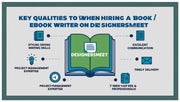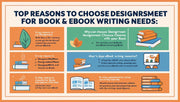In the competitive world of graphic design, your portfolio is your most valuable asset. It showcases your talent, creativity, and professional range to potential clients, employers, and collaborators. Whether you're just starting out or looking to refresh your online presence, building a stunning graphic design portfolio is essential for standing out in the design industry.
In this blog, we’ll walk you through the key steps and strategies to craft a powerful portfolio that reflects your skills and opens doors to new opportunities.
1. Define Your Design Niche and Audience
Before selecting which work to include, it’s important to identify your graphic design niche and who you want to target. Are you focusing on branding, UI/UX design, illustration, or packaging? Your portfolio should be curated based on the type of projects you want to attract.
For instance, if you specialize in logo design, your portfolio should feature a variety of logos you've created. Tailor the presentation to appeal to the clients or companies within that niche.
Keyword Highlight: graphic design niche, logo design portfolio, target audience
2. Select Only Your Best Work
Quality always trumps quantity in a graphic design portfolio. It’s tempting to include every project you’ve ever done, but a carefully selected set of 6–10 exceptional pieces will create a stronger impression than 20 average ones.
Choose projects that demonstrate your versatility, problem-solving ability, and visual creativity. Ideally, your portfolio should include a mix of real client work, personal projects, and conceptual designs to highlight both experience and creative freedom.
Keyword Highlight: best design projects, graphic design showcase, visual creativity
3. Provide Context and Process for Each Project
Simply showing final designs isn’t enough. Today’s clients and employers want to understand your design thinking process. For each project, include a brief case study explaining:
-
The client or problem
-
Your approach and tools
-
Challenges you overcame
-
The final result and impact
This format shows you’re more than just an artist—you’re a strategic designer who can deliver effective solutions.
Keyword Highlight: design thinking, project case study, strategic design
4. Use a Clean, Professional Layout
Presentation matters. Your portfolio layout should be easy to navigate, visually clean, and optimized for both desktop and mobile. Whether you’re using Behance, Dribbble, Adobe Portfolio, or your own website, the experience should be intuitive.
Avoid clutter, use plenty of whitespace, and let your work shine. Consistent formatting across all project pages adds to your professional presentation.
Keyword Highlight: portfolio layout, clean design, professional portfolio
5. Create a Strong “About” Section
Don’t forget to include a compelling About Me section. This is where you tell your story—who you are, your design background, tools you use, and what inspires you. Let your personality show while staying professional.
Adding a downloadable resume and links to your LinkedIn, Instagram, or email creates easy points of contact for potential clients or collaborators.
Keyword Highlight: About Me for designers, designer bio, contact for freelance work
6. Keep Your Portfolio Updated
A graphic design portfolio is a living document—it should grow and evolve with your skills. Set a schedule to review and update your work every few months. Remove outdated projects and replace them with recent, more relevant work.
Staying current with design trends and tools will also help you stay attractive to clients who are looking for modern solutions.
Keyword Highlight: update design portfolio, modern design work, evolving portfolio
7. Showcase Results and Testimonials
If you’ve done client work that led to measurable outcomes—such as increased engagement, conversions, or brand visibility—be sure to mention those results. Add testimonials or client feedback to build credibility and trust.
Potential clients are more likely to hire you if they see that others have had a positive experience working with you.
Keyword Highlight: client testimonials, design results, freelance designer reviews
8. Include a Clear Call-to-Action
Once someone has viewed your portfolio, what should they do next? Include a call-to-action (CTA) on your website or page, inviting them to contact you, schedule a consultation, or request a quote.
Having a CTA makes your portfolio a lead-generating tool, not just a visual gallery.
Keyword Highlight: call-to-action for designers, hire a graphic designer, get a design quote
Conclusion
A stunning graphic design portfolio is more than just a collection of pretty pictures—it’s your personal brand and professional pitch. By showcasing your best work, telling your design story, and providing an intuitive user experience, you’ll build a portfolio that opens doors and lands clients.
Whether you’re a freelance graphic designer or applying for a full-time role, investing time in your portfolio is a decision that always pays off.




